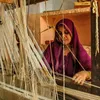National Handloom Day: 6 schemes for empowering India's weavers
India observes National Handloom Day on August 7 to celebrate weavers and the country’s handloom industry. Here are the major schemes under the National Handloom Development Programme that are attempting to galvanise the sector.

The manually-operated loom, or handloom, is a common technology used by weavers in India. Since 2015, India has observed National Handloom Day on August 7 to celebrate these weavers and the country’s handloom industry.
The Ministry of Textiles and the Office of the Development Commissioner for Handlooms are implementing a number of schemes under the National Handloom Development Programme (NHDP) to boost the handloom industry in India.
This National Handloom Day, read about the major schemes that are helping galvanise the sector:
Comprehensive Handloom Cluster Development Scheme
This scheme aims to develop large-scale handloom clusters located in easily-identifiable
geographical locations that specialise in specific handloom products.
The strategy is to develop close linkages and interdependence among key players in the cluster by improving infrastructure, storage facilities, technology in pre-loom, on-loom, post-loom operations, weaving shed, design inputs, health facilities etc.
Through these clusters, the scheme seeks to empower handloom weavers and build their capacity to enhance the competitiveness of their products in the domestic and global market in a sustainable manner.
Click here for more information.
Comprehensive Handlooms Development Scheme
This scheme also follows a cluster-based approach. Clusters will be set up at block level and have a strong concentration of handlooms. In a block, more than one cluster may also be taken up depending on the number of handlooms needed. The weavers in the cluster are provided designs developed by the Weavers’ Service Centre.
Further, financial assistance is provided for skill upgradation for clusters in a block in order to impart training in technical and managerial areas. Besides this, financial assistance is also provided for constructing dyeing units, work sheds, and more.
Click here for more information.
Revival, Reform, and Restructuring Package
This loan waiver and recapitalisation scheme was started keeping in mind the financial distress faced by handloom weavers and cooperatives due to their inability to repay debts. Under the scheme, funds will be provided for repayment of 100 percent of principal and 25 percent of interest as on the date of loan becoming NPA.
This scheme applies to primary weavers cooperative societies, apex societies, as well as individual weavers and self-help groups. However, there is a ceiling of Rs 50,000 per individual beneficiary.
Click here for more information.
Yarn Supply Scheme
Traders (and not weavers) control yarn prices, and therefore, the scheme was launched to make good quality yarn available to weavers at reasonable rates.
In this scheme, the government ensures yarn is available at ‘Mill Gate Price’, the price at the point of production (does not include transportation costs and overheads). Further, the scheme provides a 10 percent price subsidy on hank yarn (a coiled or wrapped unit of yarn). Cotton, domestic silk, wool, and linen yarn are covered under this subsidy.
Click here for more information.
North Eastern Region Textile Promotion Scheme
Under this scheme, the Ministry of Textiles and the Office of the Development Commissioner for Handlooms seek to develop the handloom sector in the North Eastern Region (NER) of India by increasing employment in the sector and boosting the value of the products it creates.
The scheme looks to set up cluster development projects, upgrade existing handloom technology, and promote and market handloom and textile products in the North Eastern Region (NER) of India.
Click here for more information.
Handloom Weavers Comprehensive Welfare Scheme
This scheme aims to provide insurance to weavers to cover accidental death, partial or total disability, pre-existing or new diseases, and provide better access to healthcare facilities. It includes two schemes, the Mahatma Gandhi Bunkar Bima Yojana and the Health Insurance Scheme.
Click here for more information.









